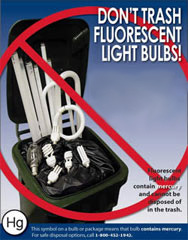Compact Fluorescent Lights: Use and Disposal
 Switching from incandescent light bulbs to compact fluorescent light bulbs (CFLs) is an effective way to reduce energy use in your residence hall or office, and prevent greenhouse gas emissions that contribute to global climate change. ENERGY STAR qualified CFLs use up to 75 percent less energy than incandescent light bulbs and last up to 10 times longer.
Switching from incandescent light bulbs to compact fluorescent light bulbs (CFLs) is an effective way to reduce energy use in your residence hall or office, and prevent greenhouse gas emissions that contribute to global climate change. ENERGY STAR qualified CFLs use up to 75 percent less energy than incandescent light bulbs and last up to 10 times longer.
CFLs do contain a small amount of mercury sealed within the glass tubing (an average of 5 milligrams), about the amount that would cover the tip of a ballpoint pen. By comparison, older thermometers contain about 500 milligrams of mercury. It would take 100 CFLs to equal that amount. Mercury currently is an essential component of CFLs and is what allows the bulb to be an efficient light source. No mercury is released when the bulbs are intact or in use.
What precautions should I take when using CFLs?
CFLs are made of glass and can break if dropped or roughly handled. Be careful when removing the bulb from its packaging, installing it, or replacing it. Always use caution and never forcefully twist the CFL into a light socket.
Disposal
Hampshire College recycles CFLs. Students should bring used CFLs to their area office and place in the padded envelopes provided. The area office will call facilities and grounds (ext. 5431) for pickup. Faculty and staff should contact environmental health and safety (ext. 6620) for pickup of their used CFLs.
How should I clean up a broken CFL bulb?
- If a College-owned/supplied fluorescent bulb breaks, contact facilities and grounds (x5431). Leave the room and restrict access until facilities and grounds personnel can clean the affected area.
- If a CFL belonging to a student or member of the faculty or staff breaks, open a window and leave the room for 15 minutes or more.
- Carefully scoop up the fragments and powder with stiff paper or cardboard and place them in a sealed container. Use disposable rubber gloves, if available (i.e., do not use bare hands). Wipe the area clean with damp paper towels or disposable wet wipes and place them in the container. Do not use a vacuum or broom to clean up the broken bulb on hard surfaces.
- Place the container and all clean-up materials in a closed plastic bag. Call environmental health and safety (ext. 6620) for pickup and proper waste disposal. Wash your hands after handling the bag.
- If a fluorescent bulb breaks on a rug or carpet, first remove all materials you can without using a vacuum cleaner, following the steps above. Sticky tape (such as duct tape) can be used to pick up small pieces and powder. If vacuuming is needed after all visible materials are removed, vacuum the area where the bulb was broken, remove the vacuum bag (or empty and wipe the canister), and put the bag or vacuum debris in two sealed plastic bags and put in the trash. Wash your hands after handling the bag.
Source: The USEPA Energy Star Program "Information on Compact Fluorscent Light Bulbs (CFLs) and Mercury" - August 2007

